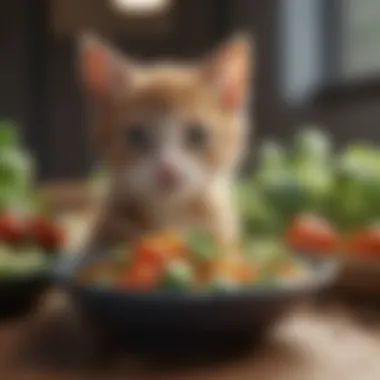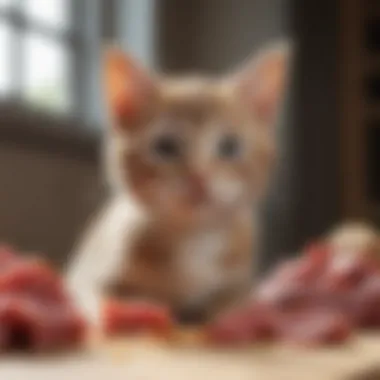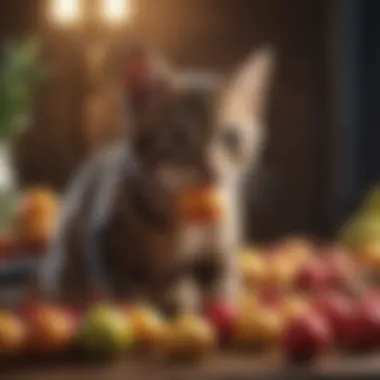The Importance of Fresh Food in Kitten Diets


Animal Species Profile
Preface to the animal species
When it comes to feline companions, kittens hold a special place in the hearts of many pet owners. Unlike adult cats, kittens are still in their formative stages, requiring precise care to ensure their proper growth and development. Born blind and deaf, these little furballs rely heavily on their mothers for nourishment and protection in the early weeks of life. This period is critical because the nourishment they receive directly influences their health as adults.
Physical characteristics and appearance
Kittens exhibit a range of physical traits that make them irresistibly cute. They are typically small, with soft fur that varies vastly in color, pattern, and length depending on their breed. Their big, round eyes are a hallmark of this stage, often blue initially and changing to their adult color as they mature. Kittens tend to have shorter legs in relation to their bodies, giving them a clumsy but endearing appearance, especially when they are just starting to learn how to walk.
Natural habitat and distribution
Domesticated cats originated from wild ancestors in various regions, with their habitats primarily linked to humans. Adult cats are adaptable creatures, but kittens do best in environments that are safe and stimulating. Their natural inclination towards hunting can be fulfilled through interactive play sessions that mimic hunting behavior, even if they are not living in the wild.
Behavior and social interactions
Kittens are known for their playful antics, which serve the dual purpose of honing their hunting skills and facilitating their development. They engage in social play with littermates, which is critical for learning important social cues and behaviors. Observing a group of kittens can be fascinating as they tumble over each other, chasing tails or pouncing on imaginary prey. These early interactions lay the foundation for their future relationships with humans and other pets.
Nutritional Needs of Kittens
Kittens require a diet that supports their rapid growth and high energy levels. The right balance of proteins, fats, vitamins, and minerals is essential. Growing kittens typically need:
- High-quality protein sources: Such as chicken, turkey, or fish to support muscle development.
- Essential fatty acids: For brain development and fur health, sources might include fish oil or flaxseed oil.
- Vitamins and minerals: Calcium and phosphorus are crucial for strong bones and teeth, while other vitamins support overall health.
Feeding a kitten requires careful attention to portion sizes and feeding frequency. Generally, 3-4 small meals throughout the day are recommended, gradually transitioning to fewer meals as they approach adulthood.
Transitioning to Fresh Foods
Making the switch from commercial diets to fresh foods can be a daunting task for many pet owners. Consider the following tips:
- Gradual introduction: Start by mixing a small amount of fresh food with their regular diet, increasing the proportion over time.
- Observe your kitten: Monitor how they respond to new food types, watching for any signs of allergies or sensitivities.
- Variety is key: Kittens can benefit from a variety of protein sources and nutrients; rotate between different meats and vegetables.
"A diverse diet is as important for kittens as it is for humans; it encourages healthy growth and development."
Consulting with Veterinarians
Before making dietary changes, it is crucial to discuss plans with a veterinarian. They can provide valuable insights into your kitten's specific nutritional needs and help tailor a dietary plan that supports optimal health. Regular health check-ups can help catch any health issues early, allowing for timely interventions if needed.
Epilogue
Understanding Kitten Nutrition
Understanding kitten nutrition is crucial for any feline enthusiast who wishes to ensure their young pet grows up healthy and strong. It’s not just about filling their bowl with any food—parents need to grasp what makes food good for kittens. Young cats are in a rapid growth phase, which means their dietary choices play a significant role in their overall development. A proper diet fuels this growth, influencing everything from their playful pounces to their long-term health.
The focus here is on three main components: essential nutritional requirements, the impact of nutrition on development, and how fresh food options fit into this framework. Understanding these elements lays the groundwork for responsible pet ownership and leads to informed decisions about what to put on the plate for these cuddly companions.
Essential Nutritional Requirements
Protein needs
Protein is the bedrock of kitten nutrition. Young felines are obligate carnivores. This means their bodies are designed to thrive on meat. Protein supports muscle growth, repair, and overall development. Without adequate protein, a kitten may experience stunted growth and increased vulnerability to diseases.
The key characteristic of protein needs is that kittens require a higher protein percentage compared to adult cats. This higher intake is crucial during their formative months. Interestingly, kittens not only need protein for growth but also for energy to fuel their playful antics and endless curiosity. The unique feature of protein needs is they can come from various sources—chicken, turkey, or fish, all come packed with amino acids that support their health. One disadvantage is that not all protein is created equal; some sources might lack essential nutrients, emphasizing the need for balanced options.
Essential fatty acids
Fatty acids are like the oil that keeps the engine running smoothly. They are crucial for various bodily processes, including brain development. Kittens benefit greatly from Omega-3 and Omega-6 fatty acids, which help in cell membrane formation and support healthy skin and coat.
The key characteristic of essential fatty acids lies in their anti-inflammatory properties, which help kittens recover from illness or injury. They are particularly efficient in brain development, enhancing cognitive function. Due to the unique feature of fatty acids being mainly found in fish and flaxseed oil, introducing these into a kitten’s diet could also bring advantages like a shinier coat and better skin health. The downside is that an imbalance—too much could lead to gastrointestinal distress—so moderation is key.
Vitamins and minerals
Vitamins and minerals are the unsung heroes in kitten nutrition. They play supportive roles in various functions, like metabolism and bone growth. Calcium and phosphorus are particularly vital for building strong bones. Another important vitamin is A, which supports vision and immune function.
What makes vitamins and minerals crucial is their role in maintaining the body’s balance. A deficiency can lead to severe health issues in kitties. These nutritional powerhouses can be found in various fresh foods like leafy greens or organ meats. However, the unique feature of vitamins and minerals is their high variability in food quality and availability, requiring careful sourcing to ensure your kitten receives the proper amounts. The disadvantage is that some synthetic supplements might not be as readily absorbed as natural sources, presenting a challenge for pet owners seeking the best for their furry friends.
Impact of Nutrition on Development
Growth milestones
The nutrition kittens receive directly impacts their growth milestones. From the moment they are born, kittens should ideally double their birth weight within the first week. Providing a nutrient-rich diet is essential for supporting these early milestones.
The key characteristic of growth milestones is that each stage relies heavily on specific dietary components. For instance, protein and calories are particularly vital during the first few months, whereas transitioned kittens may benefit more from a variety of foods as they experience growth spurts. Tracking these milestones can be immensely helpful for health assessments, and assessing weight gain can provide insights into any specific nutritional needs. A potential disadvantage of focusing narrowly on growth milestones is the risk of overlooking overall kitten well-being.
Cognitive development
Nutrition also extends to cognitive development. A proper diet has the potential to enhance a kitten's learning capabilities and behavior, particularly during the critical early life stages. Omega-3 fatty acids are known to play a significant role in brain development, making them a necessary consideration in any kitten's food regimen.
The key characteristic of cognitive development is how nutrition can influence the kitten's learning ability and social interactions. A nourishing diet can lead to better memory and quicker adaptation to their environment, which is vital in the formative years. The unique feature here would be early socialization; a well-nourished kitten with good cognitive function is more likely to be bold and curious, traits that will serve them well as they grow. On the flip side, neglecting this could lead to behavioral issues that become more entrenched as they age.


Immune system support
Finally, nutrition critically supports the immune system. A strong immune response reduces the likelihood of infections and illnesses. Vitamins such as E and C play pivotal roles in strengthening immune defenses, ensuring kittens can lead active and fun lives.
The key characteristic of immune system support is that it helps to prepare kittens for the various environmental challenges they may encounter. By providing proper nutrition, owners are armoring their pets against sickness. One unique feature is that some kittens with sensitive stomachs might struggle with specific ingredients intended for immune support. A balance must be struck, lest you end up causing more issues than benefits.
Fresh Food Options for Kittens
When considering what to feed a growing kitten, fresh food options can be an absolute game-changer. Kittens are at a critical stage of development, requiring a diet that not only meets their basic nutritional needs but also fosters optimal growth and health. Fresh foods provide a wealth of nutrients that can have a significant positive impact on their well-being. Let's dive into this topic, uncovering fascinating food choices and their benefits in a kitten's diet.
Types of Fresh Foods
Meat and fish varieties
Meat and fish varieties are the backbone of a kitten's fresh diet. These foods pack a mighty punch when it comes to protein, which is vital for building muscles and supporting overall growth. With chicken, turkey, tuna, and salmon making the top of the list, these protein sources not only satisfy their carnivorous instincts but also provide essential amino acids that kittens cannot produce on their own.
One key characteristic of meat and fish is their high palatability. Kittens are more likely to dig into their meals and finish what's served when the content is flavorful and appetizing. This trait plays a major role in ensuring they consume sufficient calories and nutrients for their growth.
The downsides? Raw meat and fish need to be handled with caution. If not prepared or stored correctly, they can harbor harmful bacteria. Always ensure that meat is fresh, and consider consulting a vet regarding the best practices for feeding raw.
Fruits and vegetables
Fruits and vegetables aren't just for humans; they can also be a beneficial addition to a kitten's diet! They provide fiber, vitamins, and minerals, which help keep everything running smoothly in the digestive system. Fresh, cooked, or pureed options like pumpkin, sweet potato, blueberries, and peas can be introduced to their diet little by little.
What's interesting about fruits and veggies is how they can offer variety. A colorful plate is appealing even for a discerning little eater, and the right mix can enhance flavor and nutrition. However, pet owners need to be aware of which fruits and vegetables are safe for kittens. Some options, like onions and grapes, are toxic.
Dairy alternatives
Dairy alternatives can be a great way to cater to kittens’ love for milk without the potential tummy troubles that traditional milk can bring. Many kittens are lactose intolerant, leading to digestive issues when whole milk is consumed. Instead, look for lactose-free options or specially formulated kitten milk replacements that match their dietary needs.
Dairy alternatives can also be high in essential vitamins and fatty acids, making them a nutritious treat. Just be sure to use them in moderation. Too much can lead to an imbalance in their diet or result in excessive caloric intake.
Nutritional Benefits of Fresh Foods
Increased digestibility
One significant advantage of feeding fresh foods to kittens is increased digestibility. Fresh ingredients are typically less processed, which allows for better absorption of nutrients. A high-quality fresh meal can make all the difference. Not only does it aid digestion, but it also maximizes the nutrients available for absorption, helping the little felines thrive.
However, not all kittens may adapt quickly to fresh foods, resulting in transitional digestive issues. It’s best to introduce these new items gradually, allowing them to acclimate without stress.
Enhanced flavor
Flavor can’t be ignored when it comes to a kitten’s food choices. Fresh foods often have a richer taste compared to processed options. This enhanced flavor can captivate picky eaters and stimulates their appetite. When kittens find their meals delightful, they tend to eat more, ensuring they get the necessary calories and nutrients.
On the other hand, while a variety of flavors can entice them, too much of a good thing might lead to some stubborn habits regarding food preferences. Consistency is key here as well.
Improved hydration
Hydration is another crucial factor often overlooked in a kitten's diet. Fresh foods can contribute significantly to their water intake, especially when incorporating wet meats or hydrating veggies. Water-rich foods keep them hydrated and can prevent urinary issues down the line.
While their thirst for fresh water should also be respected, incorporating such fresh foods into their meals can serve as a great complement. However, pet owners need to ensure that the kitten maintains access to fresh water at all times.
Preparing Fresh Food for Kittens
Preparing fresh food for kittens is not just about the culinary aspects; it’s a vital component of their overall health and development. The process of preparing these meals requires careful consideration of nutritional value, hygienic practices, and kitten preferences. This section will delve into the various methods used for cooking and storing fresh food, ensuring that they are both safe and appealing for your furry friend.
Cooking Methods
When bringing fresh food into your kitten’s diet, cooking methods come into play. They not only influence palatability but also the nutritional adequacy of the meals you decide to prepare.
Boiling and steaming
Boiling and steaming are two of the most straightforward techniques that pet owners can adopt. These methods are particularly useful for preparing meats, as they help eliminate harmful bacteria while keeping the food moist. Boiling food retains nutrients primarily in the broth, which can sometimes be saved and mixed with cat food later.
One key characteristic of boiling is its simplicity. It does not require specialized kitchen tools, making it accessible for most pet owners. However, overcooking can lead to nutrient loss. Therefore, this method is beneficial for ensuring a healthy diet but needs careful execution.
Raw food diets
On the other end of the spectrum is the buzz around raw food diets. This approach involves serving kittens fresh raw meat, bones, and some vegetables, drawing from a more natural feeding paradigm. Advocates believe that this method closely mirrors the diet of wild felines, which imparts certain health advantages.
The unique appeal of raw diets lies in their potential to promote shinier fur and healthier teeth, although concerns about bacterial contamination exist. To mitigate these issues, sourcing ingredients from reputable suppliers becomes paramount. This might not be an everyday practice due to the need for precise handling, but it has become a popular choice among those who align with raw feeding philosophies.
Mixing techniques
Mixing techniques incorporate various food types and can enhance the overall nutritional profile of a kitten's meal. By combining proteins, vegetables, and grains, pet owners can create a balanced diet catered to their kitten’s preferences. Furthermore, mixing warm and cold foods can stimulate interest and make mealtime more engaging for your pet.


The main advantage of mixing is the versatility it offers. You can cater to picky eaters by experimenting with textures and flavors, thus boosting overall acceptance and interest in healthy options. However, it’s crucial to understand food compatibility to avoid digestive upset, making this method one that requires some research and trial.
Storage and Safety
Safe storage of prepared fresh food is crucial to avoid foodborne illnesses and ensure your kitten gets the best possible nutrition. Understanding how to store and handle food appropriately can greatly affect the quality and safety of meals.
Proper refrigeration
Proper refrigeration is an indispensable practice in maintaining the integrity of fresh food. Storing food at safe temperatures helps inhibit the growth of bacteria. The fridge should ideally be set below 40°F (4°C) to minimize this risk.
A distinctive feature of refrigeration is its extended shelf life for prepared meals. This means that you can prepare larger batches and store them for later use. An important consideration is to use airtight containers to prevent cross-contamination and preserve freshness. Nevertheless, it will require routine checks to discard any spoiled items.
Freezing recommendations
When refrigeration isn't sufficient or when you wish to store food for an extended period, freezing comes into play. Freezing is an effective way to halt bacterial growth and prolong the life of prepared meals. It's advisable to portion meals out into smaller containers so that you only need to thaw what you require.
One of the distinguishing benefits of freezing is safeguarding nutritional quality. Unlike some preservation methods that can degrade nutrients, freezing preserves most of what’s beneficial for a growing kitten. However, once thawed, it’s best not to refreeze food, which could compromise the safety and quality of the meal.
Handling raw ingredients
Properly handling raw ingredients is fundamental in preventing cross-contamination. Before using them for kitten meals, it’s vital to wash hands, utensils, and countertops thoroughly. This practice helps eliminate pathogens that might pose health risks.
An essential aspect of handling lies in sourcing high-quality, safe ingredients. Choosing certified organic or human-grade meats can give you peace of mind. While this approach to prep is beneficial, it requires diligence and commitment, making it something that needs careful planning and execution to be a reliable option.
Feeding Practices and Guidelines
Feeding practices and guidelines form the backbone of a kitten’s healthy growth, influencing both their immediate wellbeing and long-term health. By understanding how to manage portion sizes, meal frequencies, and appropriate feeding practices, caretakers can significantly minimize health challenges like obesity or digestive issues that can arise from improper feeding.
Portion Control
Understanding serving sizes
When it comes to understanding serving sizes, size matters. Kittens are not little adults; their needs differ greatly. This is where proper serving sizes come into play, ensuring that kittens receive the right amount of nutrients at each feeding. By sticking to a general guideline based on age and weight, pet owners can avoid under or overfeeding.
A key characteristic of understanding serving sizes is recognition that these ratios are usually provided by either the packaging or by vets. This makes it easier for pet parents to pinpoint how much food their furry friend should be munching on. Using a measuring cup or a food scale can be a straightforward method, allowing precise measurements that contribute to a balanced diet.
However, one unique aspect here is that kittens may not always eat the same amount. Variability arises due to different activity levels or health statuses. This means that while guidelines are helpful, owners also need to remain observant. The main advantages include preventing obesity and ensuring steady growth—two critical factors for young cats.
Adjusting based on activity level
Similar to understanding serving sizes, adjusting feeding amounts based on kitten activity levels is crucial. Kittens that are more active will naturally require more calories than their more sedentary counterparts. Characteristically, this nurturing approach aligns well with the instinctual behaviors of cats, adapting to their energetic nature during growth spurts.
Being in tune with a kitten’s energy will inform the caregiver when they might need to up the serving size. An active kitten may seem perpetually hungry, prompting the consideration of a slight increase in portions. This helps cater to their nutritional needs without putting them at risk of overindulgence. However, a cautious approach is advisable; adding even a few extra grams could lead to unintended weight gains if done carelessly.
Avoiding obesity
Being mindful of avoiding obesity is paramount in today’s pet care landscape. Obesity in kittens can lead to numerous health issues down the line, from diabetes to joint problems. Recognizing its significance sets the stage for a healthier future. A notable aspect in combating obesity revolves around balanced diet and regular activity. Integrating playtime into feeding routines ensures that kittens are not just eating but also engaging in physical exercise, a two-for-one deal!
An effective strategy can involve the use of puzzle feeders or interactive toys that stimulate both the body and mind. These add excitement to their meal times and prevent them from becoming disinterested in their food. However, it’s important to note that obsessing over weight can be counterproductive. Balance is key: caregivers should remain vigilant but avoid making mealtime a source of stress for either party.
Frequency of Meals
Feeding schedules
A consistent feeding schedule aligns with kittens’ natural routines, creating a sense of stability. Establishing regular meal times rather than constant free-feeding fosters better digestion and consistent energy levels throughout the day. Kittens thrive on routine since it mimics their social structure in the wild, where they understand when to hunt and feed. This principle is beneficial because it solidifies the routine around meal times, making them predictable and calming for the kitten.
Unique features of feeding schedules allow caregivers to introduce additional interactions like bonding time pre and post-meals, fostering trust and comfort. Adhering to a schedule can lower stress in both kittens and their owners, promoting a more harmonious household. Yet, some flexibility may be needed, particularly when a kitten shows signs of hunger in between scheduled meal times.
Timing for optimal digestion
Timing is everything, especially when it comes to optimal digestion. Feeding kittens at specific times, rather than scattering meals throughout the day, establishes effective digestive cycles. A reliable timing approach may help the kitten learn when to expect their next meal, reducing anxiety.
The unique benefit of controlled timing is that it allows kittens to go through necessary digestion stages efficiently, promoting better absorption of nutrients. Regular intervals can also help in monitoring their eating habits and identifying possible health issues early on. Conversely, not adhering to a timing regimen can lead to erratic eating habits that may stress out both the kitten and the owner.
Signs of hunger or satiety
Recognizing the signs of hunger or satiety serves as an effective communication tool between a kitten and its caregiver. Kitten behavior can range from purring to kneading paws or, conversely, turning away from food. Noticing these indicators can greatly contribute to feeding accuracy. A full belly isn’t just a happy belly; it’s a healthy one.
The key aspect here is being attuned to these signals in order to adjust portions or meal frequency accordingly. When a kitten turns its nose up at food, it might be a sign to reconsider the offering or adjust the timing. The unique feature of paying attention to these signs is that it nurtures a responsive relationship; the kitten learns that its needs are understood and met. This goes a long way in establishing trust and enhancing the bonding experience.
Transitioning to Fresh Food
Transitioning a kitten to fresh food is a crucial aspect of its growth and overall health. Each kitten is unique, with individual preferences and nutritional requirements that must be considered. This transition not only leads to a healthier diet, it also involves modifying feeding habits and may take a bit of time. Often, both owners and kittens alike can face some bumps along the way as they adapt to new routines. Understanding the art and science behind this process is essential to fostering a strong and lasting bond with your feline companion.
Gradual Preface


Timeline for transitioning
The timeline for transitioning a kitten to fresh food can vary from one household to another but typically ranges from one to four weeks. Starting slow is key; it allows kittens to adjust their palates and digestive systems to the new diet. Introducing small portions of fresh food mixed with their old food can help ease this change. This gentle pace is beneficial because kittens often become wary of sudden changes in their diet. It’s like asking someone to swap their favorite dish with something they’ve never tasted before — it just takes time.
The unique feature of this gradual approach is it helps to build trust and familiarity. New flavors and textures can be overwhelming. As a kitten gets used to the fresh food, you’ll often notice a sense of excitement about meal times. However, if this transition happens too quickly, there could be a risk of gastrointestinal upset and confusion.
Measuring acceptance
Measuring acceptance can be as straightforward as simply observing the kitten's behavior and physical reactions. Is your kitten showing interest in the new food? Are they interacting with it positively? These signs are vital for gauging whether they are prepared to embrace the transition. Key indicators include sniffing, licking, and actual consumption. By keeping a close eye, you can adjust your approach based on how eagerly the kitten accepts each new introduction.
If your little one hesitates and nudges the dish away, it’s often a signal that either the food’s unfamiliarity or taste is off-putting. This aspect can serve as a catalyst for tweaking your strategy or considering alternative recipes that might appeal more.
Identifying food sensitivities
During the transition, it’s equally important to identify food sensitivities. A kitten may react negatively to certain ingredients in fresh foods, such as specific proteins or vegetables. Monitoring for signs such as changes in stool consistency, vomiting, or excessive scratching can provide valuable insights. This step is imperative because some kittens have delicate digestive systems that are easily upset by new foods.
Recognizing and responding to these sensitivities early can save both the owner and the kitten a world of discomfort. A unique feature of this process is building a food diary to keep track of what each kitten eats and their reactions. This will not only help determine what works best but also lay the groundwork for a nutritious diet moving forward.
Potential Challenges
Challenges are a natural part of the transition. From refusal of new foods to digestive issues, kittens can present a variety of hurdles.
Refusal of new foods
Refusal of new foods can be particularly disheartening. Sometimes, even the most appealing fresh meal might get the cold shoulder from a picky eater. A key characteristic here is persistence; just because a kitten turns its nose up today doesn’t mean it won't develop a taste for it in the future. Trying different types of meats or blending in beloved treats might coax them into accepting new food.
However, constantly offering the same rejected food can become an exercise in futility. You must remain flexible and willing to adapt your approach as you gauge the kitten’s preferences.
Digestive issues
Digestive issues can arise during the transition process as well, manifesting as loose stools or vomiting. These symptoms might indicate an abrupt change in diet or an intolerance to a particular ingredient. It’s best to introduce new foods one at a time and stick to them for a few days before adding anything else. This way, if any problems arise, you can more easily pinpoint the offending item.
By monitoring their condition closely, you can intervene early. If an issue persists, don’t hesitate to consult a veterinarian to help troubleshoot. They may recommend dietary adjustments or specialized foods to relieve any discomfort.
Managing picky eaters
Managing picky eaters requires a lot of patience, creativity, and often a bit of trial and error. It’s not uncommon for kittens to develop specific tastes, which can complicate efforts to diversify their diet. Frequent alterations can help, but giving in to their whims isn’t always the best approach; balance is key. You might consider varying cooking styles or adding flavors like low-sodium broth to enhance appeal.
Knowing when to push forward with new options and when to back off can be a delicate dance. While persistence is often rewarded in the long run, keeping meal times stress-free is equally essential. The journey requires understanding the kitten's personality, preferences, and tolerances, all of which contribute to their overall happy development in this exciting new phase.
Consulting Professionals
When it comes to the nutrition of kittens, consulting professionals can make all the difference. Pet owners often wear many hats- caregiver, playmate, and even chef. Yet, the knowledge required to craft a healthy and balanced diet can sometimes be out of reach. This is where the guidance of veterinary professionals and nutritional experts comes into play. Their insights often steer pet owners in the right direction, ensuring that the kittens get the dietary essentials they need while avoiding common pitfalls. The holistic approach they advocate ensures that all aspects of a kitten's health are taken into consideration, thus fostering a stronger overall well-being.
Veterinary Guidance
Assessing overall health
Assessing overall health is paramount in forming a nutrition plan for a kitten. A visit to the vet is not just about vaccinations or check-ups. Monitoring a kitten’s health can pinpoint underlying conditions that may not be immediately visible. Regular health assessments provide insights into body weight, physical condition, and even behavioral tendencies. This becomes particularly important when introducing fresh food options. A well-rounded assessment can uncover any specific nutritional deficiencies, guiding preparation decisions effectively.
This approach is beneficial because it tailors dietary choices to the individual needs of the kitten, rather than applying a one-size-fits-all recommendation. For instance, a kitten with digestive issues may need a gentler transition to fresh foods, favoring cooked options over raw ones. However, one limitation here is that not all vets will have the latest knowledge of fresh food diets, which can restrict the advice they offer.
Nutritional consultations
Nutritional consultations delve deeper into what goes on a kitten's plate. These sessions can significantly enrich a pet owner’s understanding of what a balanced meal should look like and how fresh options can replace or enhance commercial offerings. During a consultation, experts often discuss ingredient sourcing, preparation methods, and even the potential benefits of organic options to provide guidance according to the latest dietary findings.
Consultations are renowned for their focused flexibility; they can cater to specific age, breed, and health needs. Taking the time for this kind of deep dive helps craft a nuanced menu that truly benefits the growing kitten. But, a downfall might be the cost and availability of specialized nutritionists, which can narrow access to those with financial or geographical constraints.
Monitoring growth and development
Monitoring growth and development is an essential aspect of ensuring that a kitten thrives. By conducting regular evaluations, pet owners can ascertain their kitten's growth milestones against standardized charts. Observing their physical condition helps to identify if they are on track or if there are issues that require special attention.
This monitoring often reveals insights like weight variations and behavioral shifts, which are critical when adjusting dietary habits. What's especially valuable is the combination of a vet's observations with the owner's day-to-day experiences. Yet, these assessments can sometimes feel overwhelming; continuous tracking can pressure owners, leading to unnecessary anxiety regarding dietary choices.
Nutritional Experts
Dietary modifications
Dietary modifications play a crucial role in refining a kitten's diet as new information and preferences emerge. Working alongside nutritional experts can assist pet owners in identifying what adjustments are needed as their kitten matures. Perhaps ingredients need swapping, such as replacing a single protein source with a mix, or introducing new flavors to avoid mealtime monotony.
The striking feature of these modifications is their adaptability; as kittens grow, their digestive systems morph and their taste buds likely change, necessitating tweaks to maintain their enthusiasm for food. Though, one must also recognize the possibility of a gradual increase in dietary change causing digestive hiccups—so, educating oneself about monitoring responses to changes is key.
Specialized diets for health concerns
Specialized diets for health concerns are an instrumental consideration when developing a nutritious plan for kittens. While most kittens flourish on typical diets, some may present with particular health challenges requiring tailored solutions. For example, a kitten facing allergies could benefit from specific hypoallergenic recipes or grain-free options, steering clear of ingredients that trigger unwanted reactions.
This characteristic of specialized diets is what makes them so valuable in keeping these little furballs healthy. They're like customized nutrition packets designed for a purpose. On the downside, these can often be more costly and may require more planning and preparation.
Resources for ongoing education
Resources for ongoing education can help pet owners stay informed about the latest in feline nutrition. Many vets and nutritional experts supply handouts, videos, and even access to relevant online forums. Engaging with these resources can empower individuals to take control of their kitten's diets by making informed adjustments as necessary.
The advantage of these educational tools is significant; they’re perfectly tailored to pet owners’ busy lifestyles. Having quick access to information means that even the most time-strapped individuals gear up to retool their kitten’s meals when needed. That said, one must be cautious, since the flood of information available can be overwhelming or even conflicting if not sourced correctly. Establishing a reliable network of professionals and trustworthy resources is vital.
"Consulting with experts gives you the confidence that you're not just throwing spaghetti at the wall to see what sticks!"







